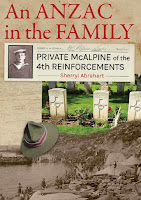1914:
Riding into war by
Susan Brocker, follows Billy and his best mate Jack as they join the Mounted
Rifles Regiment along with their horses. The story begins with the difficulties
encountered in keeping their horses alive and healthy during the sea voyage
from New Zealand to Egypt, and then the eventual move minus their horses to Gallipoli.
 1915:
Wounds of war by
Diana Menefy, is the story of Mel and her cousin Harriet, who join the NZ Army
Nursing Corps. They set sail for Egypt then serve on Hospital ships involved in
caring for wounded soldiers from Gallipoli. Letters flow between home and the
ships, nurses on the different ships, giving insights into conditions,
workloads and even shore leave.
1915:
Wounds of war by
Diana Menefy, is the story of Mel and her cousin Harriet, who join the NZ Army
Nursing Corps. They set sail for Egypt then serve on Hospital ships involved in
caring for wounded soldiers from Gallipoli. Letters flow between home and the
ships, nurses on the different ships, giving insights into conditions,
workloads and even shore leave.1917: Machines of war by Brian Falkner. New Zealander Bob Sunday's story opens in La Bellevue, France, where he is bring driven to the RAF aerodrome to begin his posting as an observer/gunner. Disturbed by a strange throbbing sound, he and his fellow recruit realise German bombers are headed to the aerodrome. The story unfolds, revealing life as part of a flying squadron, where young men fought in the air, often with a short flying career.
1918: Broken poppies by Des Hunt. Henry Hunt, a Kiwi soldier is close to enemy lines in the trenches on the battlefields of France. When he rescues a little terrier dog, Henry faces a disciplinary hearing. To his relief, Poppy is allowed to stay, for along with comfort for the soldiers (and a belief in their safety while with them), she’s a good ratter and hunter. Once again, we are exposed to descriptions and emotions of a hellish time where many were broken.
The softcover book also features over 60 black and white
photographs, as well as maps, digitised newspapers clippings, military records
and other ephemera from the time.
Listener, 10 November 2018
An article on page 28 mentions lack of understanding for medical personnel on their return to New Zealand and the ignorant attitudes of the public to their work as stretcher bearers.
Closer to home, on page 35, there is a fascinating article by Sally Blundell concerning a young Te Arawa soldier, Winiata Rewi Taphiana (Tapsell), and his part at Le Quesnoy, the place of New Zealand's famous victory.
Other recommended World War One titles
Broken branches: New Zealand families who lost three or more children in the Great War by Josh Scadden 940.467 SCA, DSR Reference only
Closer to home, on page 35, there is a fascinating article by Sally Blundell concerning a young Te Arawa soldier, Winiata Rewi Taphiana (Tapsell), and his part at Le Quesnoy, the place of New Zealand's famous victory.
Other recommended World War One titles
Broken branches: New Zealand families who lost three or more children in the Great War by Josh Scadden 940.467 SCA, DSR Reference only
The Bulford Kiwi: the kiwi we left behind by Colleen Brown 940.393 BRO, NZ Lending
Facing the
front: New Zealand’s enduring first World War by Gavin McLean 940.393 McL, NZ
Lending
Gallipoli to
the Somme: recollections of a NZ infantryman by A Aitken 940.48193 AIT, NZ
Lending
HMAS A.E.I’s
Kiwi soldier: John Reardon – one of the first 2 New Zealanders to become
submariners in 1914 by Gerry Wright 359.93 REA, DSR Reference only
Heroes of Gallipoli: gallantry of New Zealanders on Gallipoli by Richard Stowers 940.426 STO, DSR Reference only
Jack's journey: a soldier's experience of the First World War by Jack Pryce 940.48193 PRY, Lending
Make her praises heard afar: New Zealand women overseas in WWI by Anne Tolerton 940.3 TOL, NZ Lending and DSR Reference
New Zealand Methodist Chaplains and Ministers at war: the First World War through their eyes by Allan K. Davidson 940.478 DAV, NZ Lending
100 years New Zealand Military Nursing: New Zealand Nursing Service - Royal New Zealand Nursing Corps, 1915-2015 by Sherayl McNabb 940.475 McN, NZ Lending and DSR Reference
Recovery: Women's Overseas Service in World War 1 by Kay Morris Matthews 940.3082 MOR, NZ Lending and DSR Reference
The Western Front: a guide to New Zealand battlefields and memorials by Ian McGibbon 940.427 McG, Genealogy Reference only
Heroes of Gallipoli: gallantry of New Zealanders on Gallipoli by Richard Stowers 940.426 STO, DSR Reference only
Jack's journey: a soldier's experience of the First World War by Jack Pryce 940.48193 PRY, Lending
Make her praises heard afar: New Zealand women overseas in WWI by Anne Tolerton 940.3 TOL, NZ Lending and DSR Reference
New Zealand Methodist Chaplains and Ministers at war: the First World War through their eyes by Allan K. Davidson 940.478 DAV, NZ Lending
100 years New Zealand Military Nursing: New Zealand Nursing Service - Royal New Zealand Nursing Corps, 1915-2015 by Sherayl McNabb 940.475 McN, NZ Lending and DSR Reference
Recovery: Women's Overseas Service in World War 1 by Kay Morris Matthews 940.3082 MOR, NZ Lending and DSR Reference
The Western Front: a guide to New Zealand battlefields and memorials by Ian McGibbon 940.427 McG, Genealogy Reference only

























